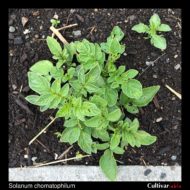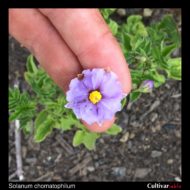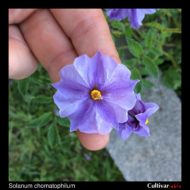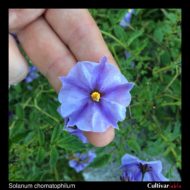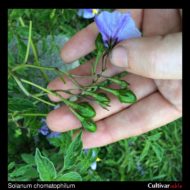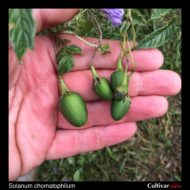Solanum chomatophilum
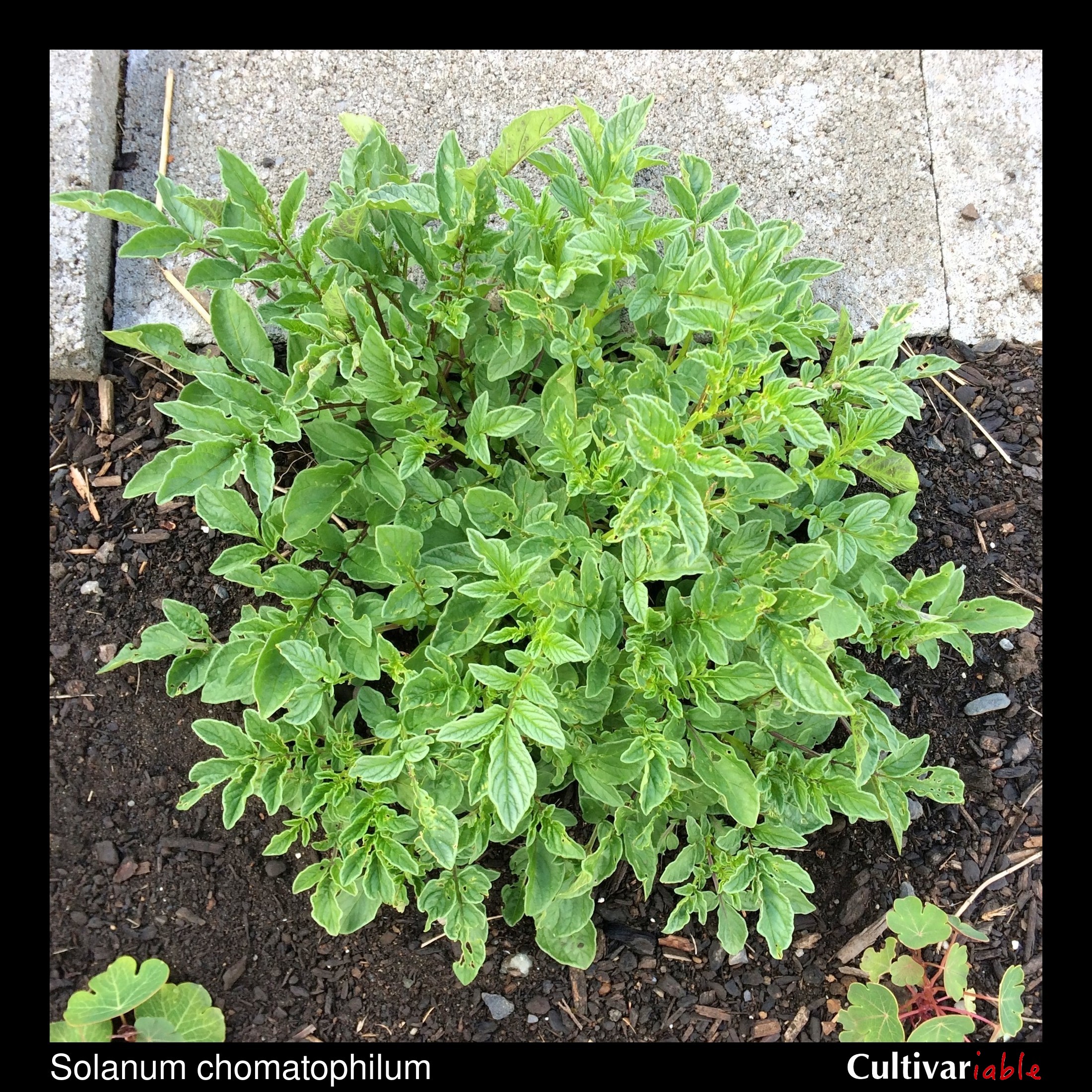
| Common Names | Amaa papa, Pishgo papa, Ridge-leaved nightshade |
| Code | chm |
| Synonyms | S. huarochiriense, S. jalcae, S. pascoense, S. taulisense |
| Clade | 3 |
| Series | Conicibaccata |
| Ploidy | Diploid (2x) |
| EBN | 2 |
| Tuberization Photoperiod | Short Day |
| Self-compatibility | No |
| Nuclear Genome | P |
| Cytoplasmic Genome | W |
| Citation | Bitter: Abh. Naturwiss. Vereine Bremen 25: 246. 1924. |
Description
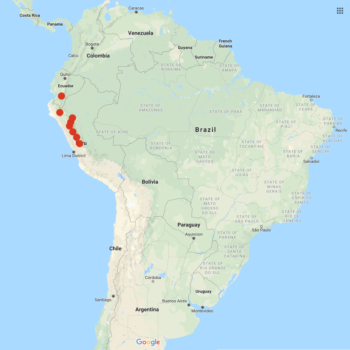
S. chomatophilum is found from southern Ecuador south through most of Peru. It is one of the most widely distributed and variable wild species in Peru. Its natural habitat is slopes, thickets, woods, and ravines at 8,200 to 13,500 feet (2500 to 4100 m) (Correll 1962).
The specific epithet, chomatophilum, means something like “tending to be grooved,” or, I suppose, “groovy.” We could call it the groovy nightshade. The name is formed from the Greek words “choma,” for “groove,” and “philein,” for “to love.” While there is no completely standardized pronunciation for scientific names, the most common way to pronounce this species is probably so-LAY-num koh-mah-TOH-fil-um.
Plants 1 to 3 feet tall. Various forms, some rosette-like, others erect. Very long stolons, from three to almost five feet, sometimes becoming woody. Tubers whitish, very small, less than an inch in diameter and moniliform (like beads on a string). Flowers purple to violet. Berries long and narrow.
Resistances
Hijmans (2003) found that at least some accessions of this species were frost resistant down to 23 degrees F (-5 C).
| Condition | Type | Level of Resistance | Source |
|---|---|---|---|
| Alternaria solani (Early Blight) | Fungus | Somewhat resistant | Jansky 2008 |
| Frost | Abiotic | Resistant | Machida-Hirano (2015) |
| Globodera pallida (Pale Cyst Nematode) | Invertebrate | Not resistant | Castelli 2003 |
| Globodera rostochiensis (Potato Cyst/Golden Nematode) | Invertebrate | Resistant | Castelli 2003 |
| Leptinotarsa decemlineata (Colorado Potato Beetle) | Invertebrate | Resistant | Pelletier (2007) |
| Macrosiphum euphorbiae (Potato Aphid) | Invertebrate | Not resistant to Resistant | Pompon 2011 |
| Myzus persicae (Green Peach Aphid) | Invertebrate | Somewhat resistant | Pompon (2010), Machida-Hirano (2015) |
| Pectobacterium carotovorum (Blackleg/Soft Rot) | Bacteria | Somewhat resistant | Chung 2011 |
| Phytophthora infestans (Late Blight) | Fungus | Not resistant | Gonzales 2002 |
| Phytophthora infestans (Late Blight) | Fungus | Some resistance | Karki 2020 |
| Potato Virus Y (PVY) | Virus | Not resistant | Cai 2011 |
Glykoalkaloid content
Images
Cultivation
Chen (1976) found that this species reaches its maximum frost resistance (about 17 degrees F, -8.3 C) following a three week period of shortening photoperiod and reducing day and night temperatures.
Towill (1983) found that seeds of different accessions of this species stored at 1 to 3 degrees C germinated at 36% after 14 years, 50% after 17 years, and 58% after 20 years.
Breeding
Crosses with S. tuberosum
Watanabe (1991) found that 4.3% of varieties of this species produced 2n pollen, which would be effectively tetraploid and probably 4EBN.
| Female | Male | Berry Set |
Seed Set | Germ | Ploidy | Source |
|---|---|---|---|---|---|---|
| S. chomatophilum | S. tuberosum 2x |
High | Low | Ochoa (2004) | ||
| S. chomatophilum |
S. tuberosum 2x | Yes | No | Villamon 2005 | ||
| S. chomatophilum | S. tuberosum 4x | None | None | Jackson (1999) | ||
| S. tuberosum 2x |
S. chomatophilum | Moderate | Low | Ochoa (2004) | ||
| S. tuberosum 2x | S. chomatophilum |
Yes | No | Villamon 2005 | ||
| S. tuberosum 4x | S. chomatophilum | Low | Minimal | Jackson (1999) |
Crosses with other species
Jackson (1999) found 3-11% 2n pollen for varieties of this species.
| Female | Male | Berry Set |
Seed Set | Germ | Ploidy | Source |
|---|---|---|---|---|---|---|
| S. acaule | S. chomatophilum | High | High | Ochoa (2004) | ||
| S. albicans | S. chomatophilum | Moderate | Low | Ochoa (2004) | ||
| S. candolleanum (as S. bukasovii) | S. chomatophilum | Moderate | Moderate | Ochoa (2004) | ||
| S. cantense | S. chomatophilum | None | None | Ochoa (2004) | ||
| S. chiquidenum | S. chomatophilum | Moderate | Low | Ochoa (2004) | ||
| S. chomatophilum | S. acaule | High | Moderate | Ochoa (2004) | ||
| S. chomatophilum | S. albicans | High | Low | Ochoa (2004) | ||
| S. chomatophilum | S. x blanco-galdosii | Low | High | Ochoa (2004) | ||
| S. chomatophilum | S. boliviense (as S. megistacrolobum) | High | Moderate | Ochoa (2004) | ||
| S. chomatophilum | S. candolleanum (as S. bukasovii) | High | Moderate | Ochoa (2004) | ||
| S. chomatophilum | S. cantense | Low | Moderate | Ochoa (2004) | ||
| S. chomatophilum | S. chiquidenum | Moderate | Low | Ochoa (2004) | ||
| S. chomatophilum | S. colombianum (as S. jaenense) | Low | Low | Ochoa (2004) | ||
| S. chomatophilum | S. contumazaense | Low | None | Ochoa (2004) | ||
| S. chomatophilum | S. dolichocremastrum | Moderate | High | Ochoa (2004) | ||
| S. chomatophilum | S. huancabambense | None | None | Ochoa (2004) | ||
| S. chomatophilum | S. humectophilum | Moderate | High | Ochoa (2004) | ||
| S. chomatophilum | S. hypacrarthrum | Moderate | None | Ochoa (2004) | ||
| S. chomatophilum | S. immite | Moderate | High | Ochoa (2004) | ||
| S. chomatophilum | S. laxissimum | Moderate | High | Ochoa (2004) | ||
| S. chomatophilum | S. lignicaule | Moderate | Moderate | Ochoa (2004) | ||
| S. chomatophilum | S. limbaniense | Low | High | Ochoa (2004) | ||
| S. chomatophilum | S. mochiquense | High | High | Ochoa (2004) | ||
| S. chomatophilum | S. multiinterruptum | High | Moderate | Ochoa (2004) | ||
| S. chomatophilum | S. paucissectum | Low | Low | Ochoa (2004) | ||
| S. chomatophilum | S. peloquinianum | Moderate | Moderate | Ochoa (2004) | ||
| S. chomatophilum | S. piurae | Moderate | Moderate | Ochoa (2004) | ||
| S. chomatophilum | S. raphanifolium | Moderate | None | Ochoa (2004) | ||
| S. chomatophilum | S. raquialatum | Moderate | Moderate | Ochoa (2004) | ||
| S. chomatophilum | S. rhomboideilanceolatum | Moderate | Moderate | Ochoa (2004) | ||
| S. chomatophilum | S. simplicissimum | High | None | Ochoa (2004) | ||
| S. chomatophilum | S. sogarandinum | Moderate | Moderate | Ochoa (2004) | ||
| S. chomatophilum | S. wittmackii | None | None | Ochoa (2004) | ||
| S. colombianum
(as S. jaenense) |
S. chomatophilum | Moderate | None | Ochoa (2004) | ||
| S. contumazaense | S. chomatophilum | None | None | Ochoa (2004) | ||
| S. dolichocremastrum | S. chomatophilum | Low | None | Ochoa (2004) | ||
| S. huancabambense | S. chomatophilum | High | High | Ochoa (2004) | ||
| S. humectophilum | S. chomatophilum | Moderate | Moderate | Ochoa (2004) | ||
| S. hypacrarthrum | S. chomatophilum | None | None | Ochoa (2004) | ||
| S. immite | S. chomatophilum | Moderate | None | Ochoa (2004) | ||
| S. laxissimum | S. chomatophilum | Low | None | Ochoa (2004) | ||
| S. lignicaule | S. chomatophilum | Low | None | Ochoa (2004) | ||
| S. limbaniense | S. chomatophilum | Moderate | None | Ochoa (2004) | ||
| S. mochiquense | S. chomatophilum | None | None | Ochoa (2004) | ||
| S. multiinterruptum | S. chomatophilum | High | None | Ochoa (2004) | ||
| S. paucissectum | S. chomatophilum | High | Moderate | Ochoa (2004) | ||
| S. peloquinianum | S. chomatophilum | Moderate | Moderate | Ochoa (2004) | ||
| S. piurae | S. chomatophilum | Moderate | Moderate | Ochoa (2004) | ||
| S. raphanifolium | S. chomatophilum | Low | None | Ochoa (2004) | ||
| S. raquialatum | S. chomatophilum | Moderate | Moderate | Ochoa (2004) | ||
| S. rhomboideilanceolatum | S. chomatophilum | High | Moderate | Ochoa (2004) | ||
| S. simplicissimum | S. chomatophilum | Moderate | None | Ochoa (2004) | ||
| S. sogarandinum | S. chomatophilum | Low | None | Ochoa (2004) | ||
| S. wittmackii | S. chomatophilum | Low | None | Ochoa (2004) |
References
Solanum chomatophilum at Solanaceae Source

